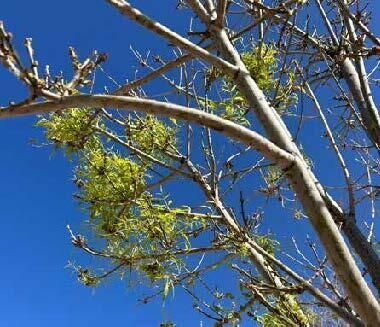
UTAH PLANT HEALTH - Utah State University Extension
Tree Injury Due to Herbicides
In summer 2024, several Utah State University (USU) county Extension offices and the Utah Plant Pest Diagnostic Lab (UPPDL) received calls about unusual symptoms on landscape trees such as honeylocust, ash, boxwood, and Chinese pistache (Pistacia chinensis). Symptoms included witches’ brooms, epicormic branching (sprouting from latent buds on the trunk), oozing resin or sap, branch dieback, small leaves and leaf
chlorosis (yellowing).
The UPPDL conducted several diagnostic tests for an insect or disease cause, and they all were negative. The damage, however, matched symptoms caused by the herbicide ingredients, imazapyr and imazapic. Both are found in herbicides labeled with “extended control.”
The UPPDL sent samples to a specialized testing facility, and one came back positive for imazapyr and another for imazapyr and imazapic.
If used incorrectly, very small concentrations (13 parts per billion ormore) of either herbicide can cause serious damage to woody plants. The herbicides break down very slowly in soils with high clay content, high pH, and
drought conditions (Tu et al. 2004) and are very water-soluble.
To avoid damaging woody plants when targeting weeds, it is important to read the herbicide product’s ingredients and apply it as labeled. Going by the product name alone is not sufficient.If used incorrectly, very small
concentrations (13 parts per billion or
more) of either herbicide can cause serious damage to woody plants. The herbicides break down very slowly in soils with high clay content, high pH, and
drought conditions (Tu et al. 2004) and are very water-soluble. To avoid damaging woody plants when targeting weeds, it is important to read the herbicide product’s ingredients and apply it as labeled. Going by the product name alone is not sufficient.
PRODUCT NAMES ≠ INGREDIENTS
Example 1
• “WeedKilz” contains ingredient A.
• “WeedKilz Extended Control”
contains ingredient A (often
in a lower concentration) plus
ingredient B (which could be
imazapyr, imazapic or another
related chemical).
• “WeedKilz with Ingredient C” may
not contain ingredient A at all but
be composed of entirely different
ingredients.
Example 2
“WeederDozer” is a long-known
product that has historically contained
ingredient D.
Recently, the manufacturer changed the
product, and it now contains ingredient
E (and possibly additional ingredients)
but the brand name remains the same.
Reference
Tu, M. Hurd C and Randall J.M. (2004). Imazapyr. Weed Control Methods Handbook (https://www. invasive.org/gist/products/handbook/17.imazapyr.pdf
(accessed: 3-28-2025).
Read the full issue here.
Utah Plant Health - Utah IPM Program & Plant Pest Diagnostic Laboratory - Spring/Summer Vol XVII
